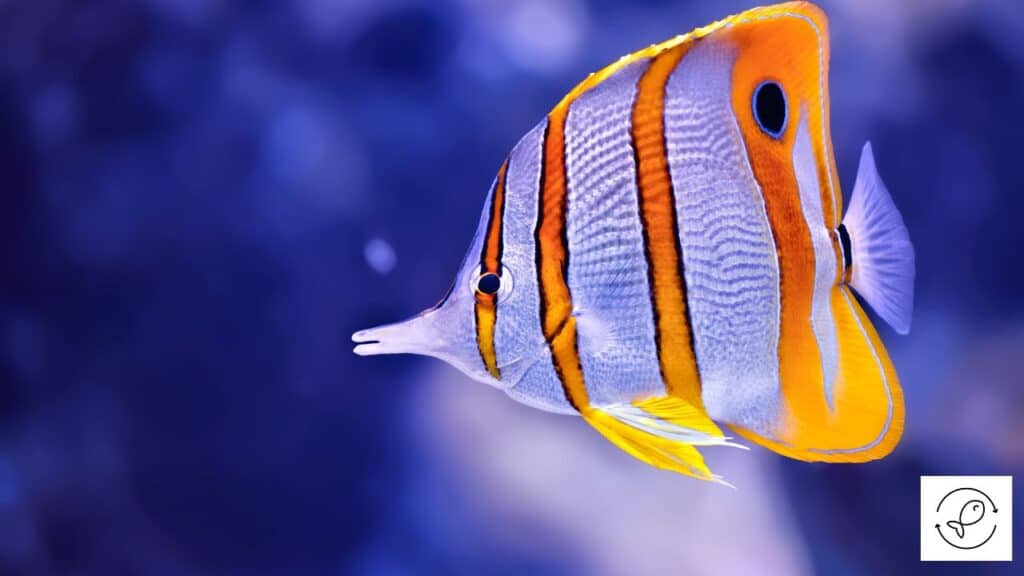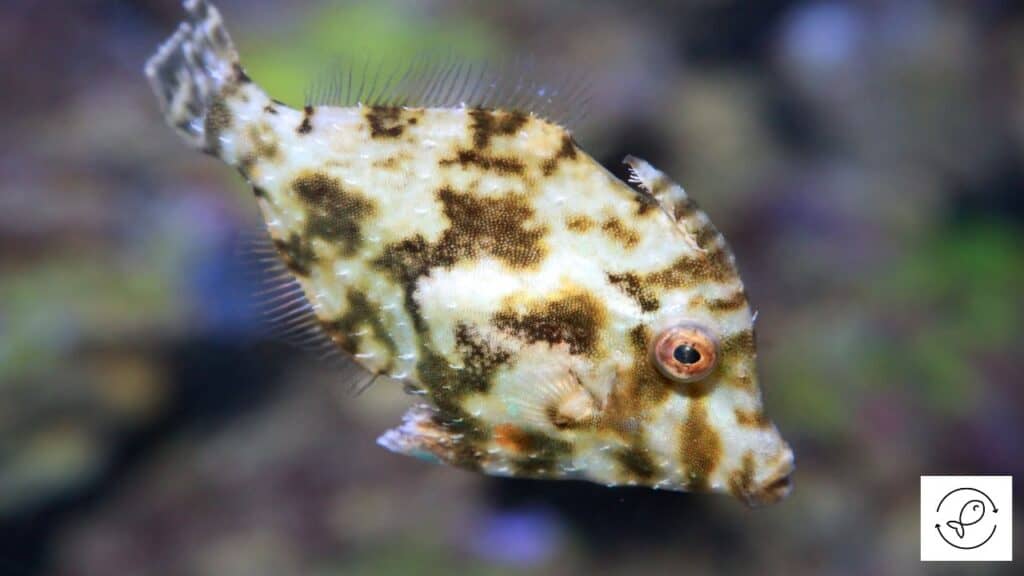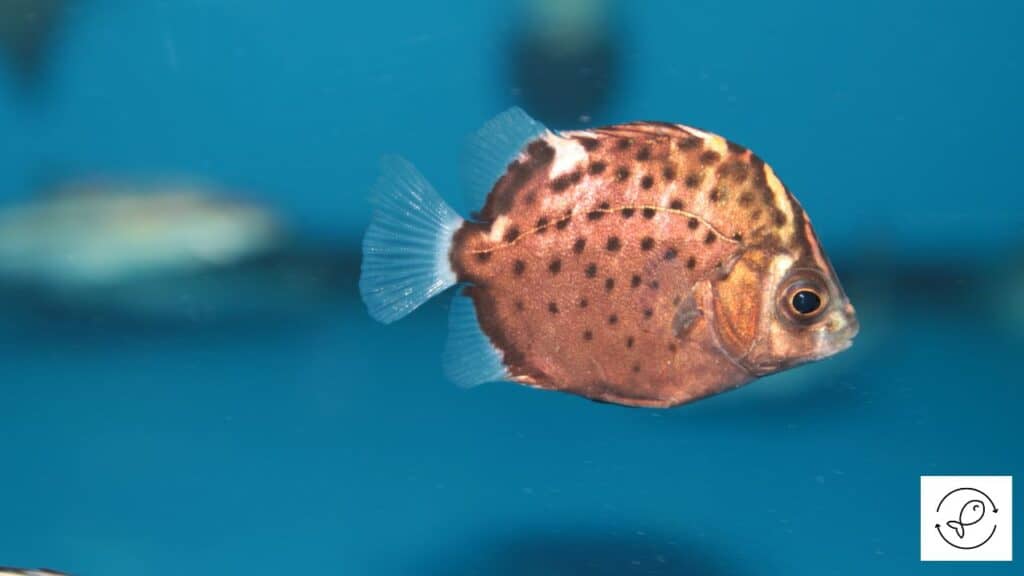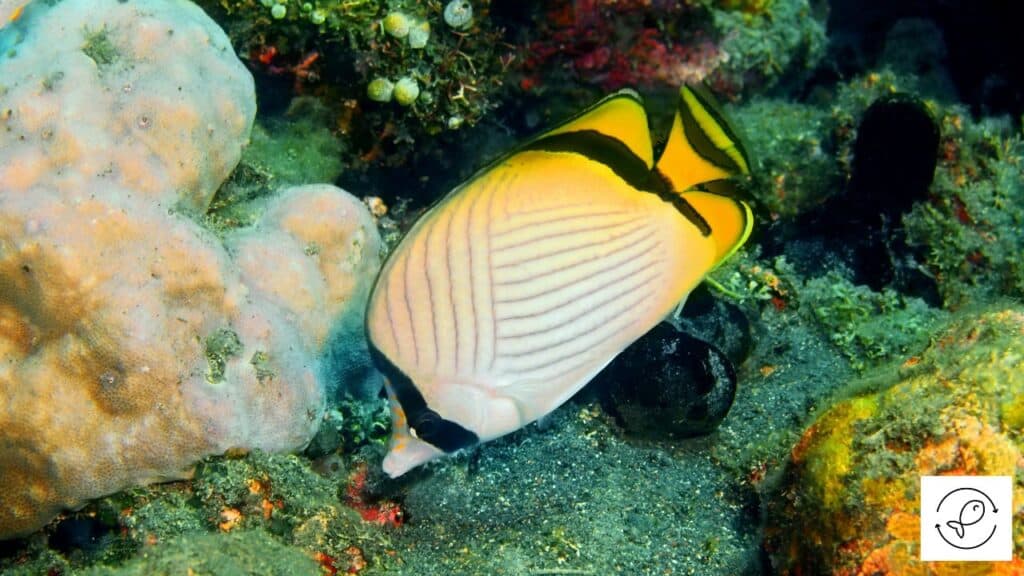Aiptasia are sea anemones that live on mangrove roots and rigid substrates.
So it’s natural that they will grow in your reef aquarium if you have live rocks or corals.
Unfortunately, they have stingy cells that can cause damage to corals, fish, and invertebrates in your reef tank. So…
Given below are the fish species that eat aiptasia.
Butterflyfish

Butterflyfish belong to the Chaetodontidae family.
They’re primarily found in the tropical reef waters of the Atlantic, Indian, and Pacific oceans.
Some species of butterflyfish are effective in controlling aiptasia.
However, all butterflyfish species aren’t reef-safe as they will eat corals in your reef aquarium.
Given below are a few butterflyfish species that you can keep to control aiptasia.
Copperband Butterflyfish
Copperband butterflyfish are reef-safe as they won’t nip at corals.
They’re a great option to eliminate the aiptasia population from your reef aquarium.
These fish prefer feeding on aiptasia anemones and can sometimes refuse to eat anything else.
So in the absence of aiptasia, these fish can have a difficult time in your reef aquarium.
Therefore, you must be careful while considering them for your reef aquarium.
Besides aiptasia, copperband butterflyfish also prey on invertebrates like tube worms, clams, and mollusks.
Auriga or Threadfin Butterflyfish
Auriga or Threadfin butterflyfish is a popular butterflyfish species. These fish can help eliminate aiptasia from your aquarium.
However, threadfin butterflyfish aren’t reef-safe and will eat corals and invertebrates in your reef aquarium.
These hardies thrive in captivity and are considered for fish-only aquariums.
Klein’s Butterflyfish
Klein’s butterflyfish are also known as Sunburst butterflyfish. These hardies can quickly adapt to reef aquariums.
These fish eat aiptasia and can easily control the population of these anemones.
Unlike other butterflyfish, they usually don’t eat most corals.
However, sunburst butterflyfish can occasionally nip at corals like leathers.
Pearlscale Butterflyfish
Pearlscale butterflyfish is a species of butterflyfish that can also help you remove the pest aiptasia anemones from your marine aquarium.
Like most butterflyfish species, they’re not reef-safe because they nibble on soft corals, stony polyps, and invertebrates like ornamental shrimp, tube worms, and anemones.
Raccoon Butterflyfish
Many aquarists use raccoon butterflyfish to control and eliminate aiptasia.
These fish are hardies and do well in a captive environment.
However, raccoon butterflyfish are aggressive coral eaters.
This means they will eat the beneficial anemones and corals, along with the pest anemones.
So you must think carefully before keeping them as they aren’t reef-safe and will devour corals and invertebrates from the reef aquarium.
Bristletail Filefish

The bristletail filefish, also known as aiptasia-eating filefish, is a marine filefish species.
It belongs to the family Monacanthidae and is the only filefish that eats aiptasia.
In the wild, these fish mainly live around seagrass beds in the shallow reefs of the Indian and Pacific oceans.
These filefish are usually fond of aiptasia, so they’re an exciting and valuable addition to a home aquarium.
They’re excellent at eradicating the aiptasia anemones from an aquarium, but they can also feed on other fleshy corals if left unchecked.
Some aquarists prefer buying captive-bred filefish as they’re known to leave corals aside and go after only the pest anemones.
However, bristletail filefish don’t just eat aiptasia. They eat other types of food too.
These fish can quickly adapt to various substrates and can be kept in different types of aquariums.
Pufferfish

Pufferfish, also known as the blowfish, globefish, and swellfish, belong to the family Tetraodontidae and inhabit the coral reefs of the Atlantic, Indian, and Pacific oceans.
Some pufferfish are known to eat aiptasia.
However, you need to research before putting them in a reef tank because they will also snack on various invertebrates.
Given below are a few pufferfish species that are usually considered for removing aiptasia from aquariums.
Guinea Fowl Pufferfish
Guinea fowl pufferfish is an excellent choice to eliminate aiptasia from your marine aquarium.
However, these large-sized fish are unsuitable for mini reef or small aquariums.
These fish aren’t reef-safe and will eat lobes and other soft corals.
These predatory fish will also feed on meaty invertebrates like clams, krill, squid, and hard-shelled shrimp.
Sharpnosed Pufferfish
Sharpnosed or spotted sharpnosed pufferfish eat aiptasia and can help reduce the pest anemones from your marine aquarium.
These fish are small and a good option for small tanks.
They can be kept in an aquarium but must be watched constantly so that they don’t nibble on coral polyps.
They mainly eat small crustaceans, which means they can’t be housed with any tiny invertebrates.
Scat Fish

Scat fish belong to the family Scathophagidae and are also known as scats.
They inhabit the warm waters of the Indo-Pacific region.
These fish are mainly found in harbors, brackish estuary, and the lower stretches of freshwater rivers.
Some scat fish are known to eat aiptasia as they’re part of the varied diet of these fish.
Given below are a few scat fish species that are kept in aquariums to remove aiptasia.
Spotted Scats
Spotted scat fish are natural scavengers that live in brackish waters.
They’re omnivores that will eat everything, including aiptasia.
They’re relatively easy to care for and can acclimate to freshwater or saltwater aquariums.
Spotted scat fish aren’t fussy eaters.
These fish can eat a diverse diet consisting of plant and meat-based food and help you remove aiptasia from your aquarium.
Silver Scats
Silver scat fish is another option that can help you control and eliminate the pest anemones from your marine aquarium.
They’re brackish water fish but require marine conditions to thrive once they grow up.
These fish will not bother the corals inside your aquarium.
Besides aiptasia, silver scats eat certain algae and can be fed small invertebrates as part of their diet.

